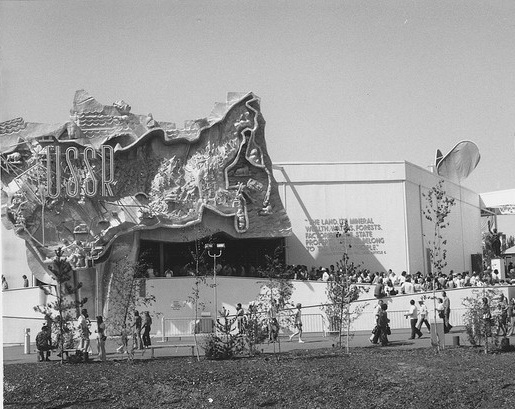|
J. William T. "Bill" Youngs, The Fair and the Falls: Spokane’s Expo ’74: Transforming an American Environment, Chapter Eleven
|
"The deputy chief of Soviet Exhibitions Abroad, Vladimir N.Pavlov, left, receives an Expo ‘74 information kit from Expo president King Cole, right." Courtesy of the Spokesman Review
|
Chapter Eleven: Wooing the Foreign Exhibitors
|
SummaryThe greatest challenge confronting the fledgling exposition was signing up exhibitors. Expo representatives circled the globe, using persuasion, personal contacts, and politics to woo foreign states to attend their fair. The results were mixed: although only nine finally agreed to participate, Expo still managed to mount an impressive international display, including a large Soviet pavilion.
|
Author reads from the Text
"An interior market, weak in population"
Jacques Sol-Rolland, a representative of the Bureau of International Expositions, came to Spokane to assess it for the world's fair. In his report he noted that the city was located in "'an interior market, weak in population and great in dimension.' Urbane Parisian that he was, he noted somewhat condescendingly that Spokane's location 'did not prepare them particularly well to conduct relations with foreign states in an international setting.'...
"Monsieur Sol-Rolland's visit to Spokane underscored a fundamental problem of hosting a world's fair. The city by the Spokane River -- unprepared though it might be, in the eyes of the sophisticated Frenchman, to engage in relations with foreign countries -- must now engage in a world-wide hunt for participants in their ambitious project. Roughly a hundred years before, James Glover had waited anxiously for a few neighboring Indians to come to his store with furs to begin the economic life of his fledgling community. Now the modern boosters of Spokane waited eagerly for news of clients from around the state, the nation, and the world."
"Monsieur Sol-Rolland's visit to Spokane underscored a fundamental problem of hosting a world's fair. The city by the Spokane River -- unprepared though it might be, in the eyes of the sophisticated Frenchman, to engage in relations with foreign countries -- must now engage in a world-wide hunt for participants in their ambitious project. Roughly a hundred years before, James Glover had waited anxiously for a few neighboring Indians to come to his store with furs to begin the economic life of his fledgling community. Now the modern boosters of Spokane waited eagerly for news of clients from around the state, the nation, and the world."
"I was looking for my seatbelt!"
"Several Spokanites made overseas trips on behalf of the fair, including Mel Alter, Walt Toly, Rod Lindsay, and King Cole. During the long months before the exposition, Cole was airborne so often that he once mistook a barber's chair for an aircraft seat. Soon after a long return flight to Spokane, he sat down for a haircut and immediately began to fidget. 'Is there something wrong?' the barber asked. 'My gosh,' Cole replied, 'I was looking for my seatbelt!'"
"Much like a courtship"
"In a plan adopted by Expo for seeking international exhibitors, Western Europe headed the list of targeted regions. According to the document: 'Only continual appearances of the fair's leaders in European capitals will provide results. The policy should be carried out to the point of embarrassment. Above all, this is much like a courtship. The suitor must 'dance attention' on his beloved to convince her that he is sincere. And when the beloved is France, the dancing must be vigorous!'"

